Project Management Case Study: TAHS Program for High School Students
VerifiedAdded on 2023/04/23
|20
|2685
|68
Project
AI Summary
This project management case study analyzes the development of a training and apprenticeship program (TAHS) for high school students at Globex. The project encompasses a comprehensive project charter, including an overview of the project's goals, scope, and measurable organizational value (MOV), with a focus on customer satisfaction and financial gains. It outlines the project's scope, detailing in-scope and out-of-scope elements, and presents a scope management plan. The assignment further includes a work breakdown structure, detailing project milestones, activities, resources, and time estimations using a Gantt chart, along with a detailed project budget and a time-phased budget. A risk analysis and management plan identify potential risks and mitigation strategies. The project also includes a quality management plan, outlining verification and validation activities. The project concludes with a closure checklist, evaluation development, and an annotated bibliography, demonstrating a comprehensive approach to project management principles. This document is a student contribution to Desklib.
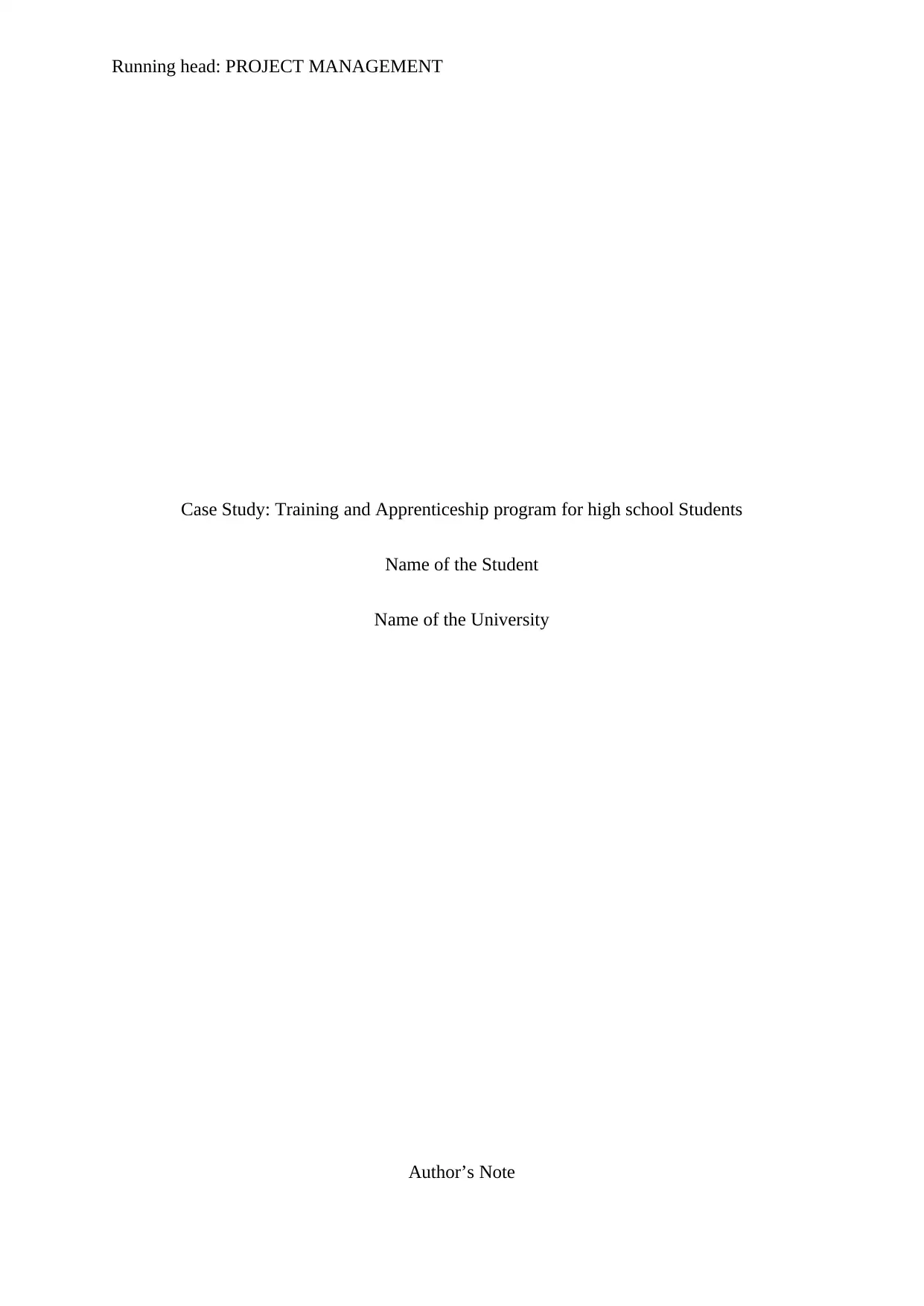
Running head: PROJECT MANAGEMENT
Case Study: Training and Apprenticeship program for high school Students
Name of the Student
Name of the University
Author’s Note
Case Study: Training and Apprenticeship program for high school Students
Name of the Student
Name of the University
Author’s Note
Paraphrase This Document
Need a fresh take? Get an instant paraphrase of this document with our AI Paraphraser
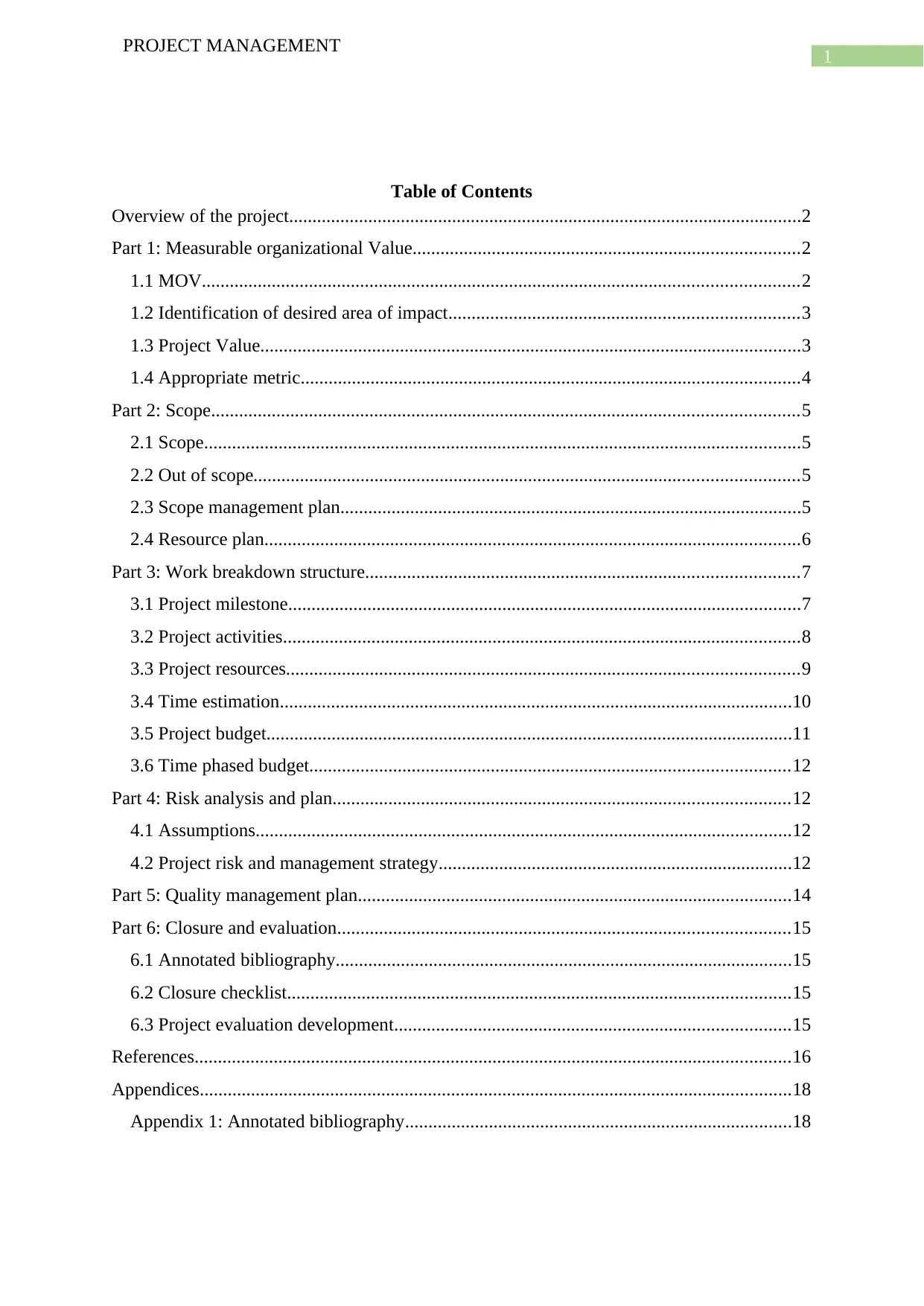
1
PROJECT MANAGEMENT
Table of Contents
Overview of the project..............................................................................................................2
Part 1: Measurable organizational Value...................................................................................2
1.1 MOV................................................................................................................................2
1.2 Identification of desired area of impact...........................................................................3
1.3 Project Value....................................................................................................................3
1.4 Appropriate metric...........................................................................................................4
Part 2: Scope..............................................................................................................................5
2.1 Scope................................................................................................................................5
2.2 Out of scope.....................................................................................................................5
2.3 Scope management plan...................................................................................................5
2.4 Resource plan...................................................................................................................6
Part 3: Work breakdown structure.............................................................................................7
3.1 Project milestone..............................................................................................................7
3.2 Project activities...............................................................................................................8
3.3 Project resources..............................................................................................................9
3.4 Time estimation..............................................................................................................10
3.5 Project budget.................................................................................................................11
3.6 Time phased budget.......................................................................................................12
Part 4: Risk analysis and plan..................................................................................................12
4.1 Assumptions...................................................................................................................12
4.2 Project risk and management strategy............................................................................12
Part 5: Quality management plan.............................................................................................14
Part 6: Closure and evaluation.................................................................................................15
6.1 Annotated bibliography..................................................................................................15
6.2 Closure checklist............................................................................................................15
6.3 Project evaluation development.....................................................................................15
References................................................................................................................................16
Appendices...............................................................................................................................18
Appendix 1: Annotated bibliography...................................................................................18
PROJECT MANAGEMENT
Table of Contents
Overview of the project..............................................................................................................2
Part 1: Measurable organizational Value...................................................................................2
1.1 MOV................................................................................................................................2
1.2 Identification of desired area of impact...........................................................................3
1.3 Project Value....................................................................................................................3
1.4 Appropriate metric...........................................................................................................4
Part 2: Scope..............................................................................................................................5
2.1 Scope................................................................................................................................5
2.2 Out of scope.....................................................................................................................5
2.3 Scope management plan...................................................................................................5
2.4 Resource plan...................................................................................................................6
Part 3: Work breakdown structure.............................................................................................7
3.1 Project milestone..............................................................................................................7
3.2 Project activities...............................................................................................................8
3.3 Project resources..............................................................................................................9
3.4 Time estimation..............................................................................................................10
3.5 Project budget.................................................................................................................11
3.6 Time phased budget.......................................................................................................12
Part 4: Risk analysis and plan..................................................................................................12
4.1 Assumptions...................................................................................................................12
4.2 Project risk and management strategy............................................................................12
Part 5: Quality management plan.............................................................................................14
Part 6: Closure and evaluation.................................................................................................15
6.1 Annotated bibliography..................................................................................................15
6.2 Closure checklist............................................................................................................15
6.3 Project evaluation development.....................................................................................15
References................................................................................................................................16
Appendices...............................................................................................................................18
Appendix 1: Annotated bibliography...................................................................................18
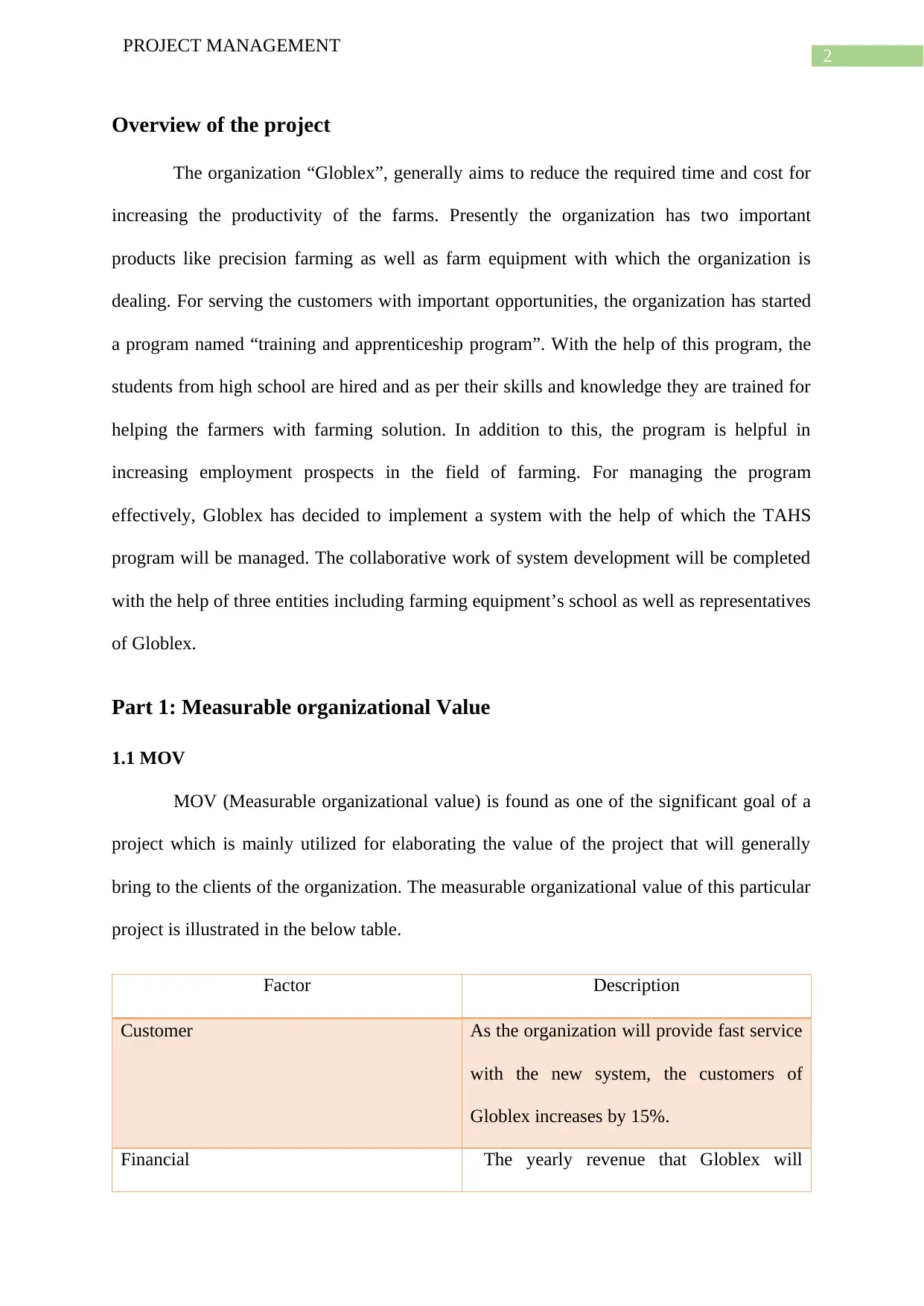
2
PROJECT MANAGEMENT
Overview of the project
The organization “Globlex”, generally aims to reduce the required time and cost for
increasing the productivity of the farms. Presently the organization has two important
products like precision farming as well as farm equipment with which the organization is
dealing. For serving the customers with important opportunities, the organization has started
a program named “training and apprenticeship program”. With the help of this program, the
students from high school are hired and as per their skills and knowledge they are trained for
helping the farmers with farming solution. In addition to this, the program is helpful in
increasing employment prospects in the field of farming. For managing the program
effectively, Globlex has decided to implement a system with the help of which the TAHS
program will be managed. The collaborative work of system development will be completed
with the help of three entities including farming equipment’s school as well as representatives
of Globlex.
Part 1: Measurable organizational Value
1.1 MOV
MOV (Measurable organizational value) is found as one of the significant goal of a
project which is mainly utilized for elaborating the value of the project that will generally
bring to the clients of the organization. The measurable organizational value of this particular
project is illustrated in the below table.
Factor Description
Customer As the organization will provide fast service
with the new system, the customers of
Globlex increases by 15%.
Financial The yearly revenue that Globlex will
PROJECT MANAGEMENT
Overview of the project
The organization “Globlex”, generally aims to reduce the required time and cost for
increasing the productivity of the farms. Presently the organization has two important
products like precision farming as well as farm equipment with which the organization is
dealing. For serving the customers with important opportunities, the organization has started
a program named “training and apprenticeship program”. With the help of this program, the
students from high school are hired and as per their skills and knowledge they are trained for
helping the farmers with farming solution. In addition to this, the program is helpful in
increasing employment prospects in the field of farming. For managing the program
effectively, Globlex has decided to implement a system with the help of which the TAHS
program will be managed. The collaborative work of system development will be completed
with the help of three entities including farming equipment’s school as well as representatives
of Globlex.
Part 1: Measurable organizational Value
1.1 MOV
MOV (Measurable organizational value) is found as one of the significant goal of a
project which is mainly utilized for elaborating the value of the project that will generally
bring to the clients of the organization. The measurable organizational value of this particular
project is illustrated in the below table.
Factor Description
Customer As the organization will provide fast service
with the new system, the customers of
Globlex increases by 15%.
Financial The yearly revenue that Globlex will
⊘ This is a preview!⊘
Do you want full access?
Subscribe today to unlock all pages.

Trusted by 1+ million students worldwide
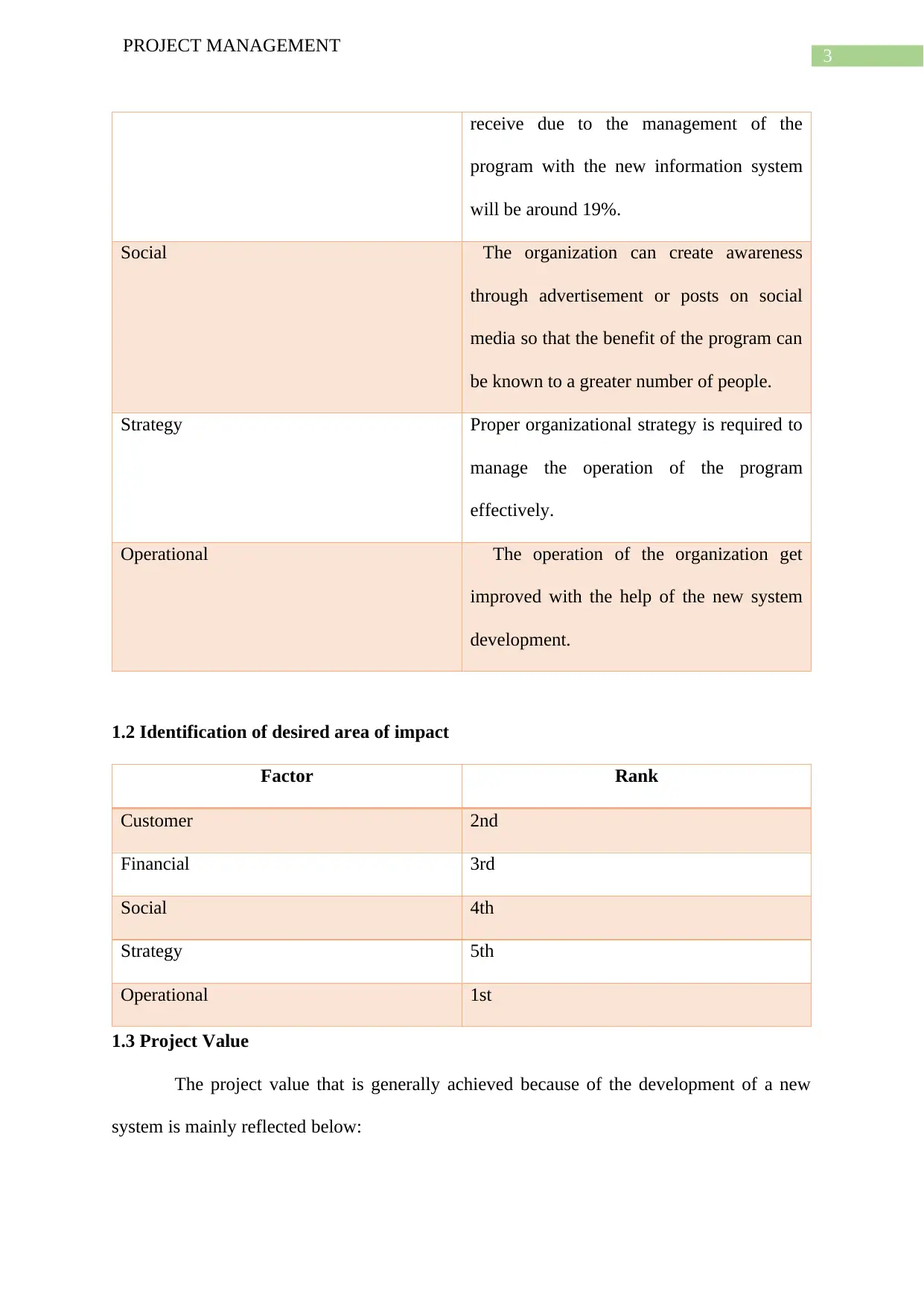
3
PROJECT MANAGEMENT
receive due to the management of the
program with the new information system
will be around 19%.
Social The organization can create awareness
through advertisement or posts on social
media so that the benefit of the program can
be known to a greater number of people.
Strategy Proper organizational strategy is required to
manage the operation of the program
effectively.
Operational The operation of the organization get
improved with the help of the new system
development.
1.2 Identification of desired area of impact
Factor Rank
Customer 2nd
Financial 3rd
Social 4th
Strategy 5th
Operational 1st
1.3 Project Value
The project value that is generally achieved because of the development of a new
system is mainly reflected below:
PROJECT MANAGEMENT
receive due to the management of the
program with the new information system
will be around 19%.
Social The organization can create awareness
through advertisement or posts on social
media so that the benefit of the program can
be known to a greater number of people.
Strategy Proper organizational strategy is required to
manage the operation of the program
effectively.
Operational The operation of the organization get
improved with the help of the new system
development.
1.2 Identification of desired area of impact
Factor Rank
Customer 2nd
Financial 3rd
Social 4th
Strategy 5th
Operational 1st
1.3 Project Value
The project value that is generally achieved because of the development of a new
system is mainly reflected below:
Paraphrase This Document
Need a fresh take? Get an instant paraphrase of this document with our AI Paraphraser
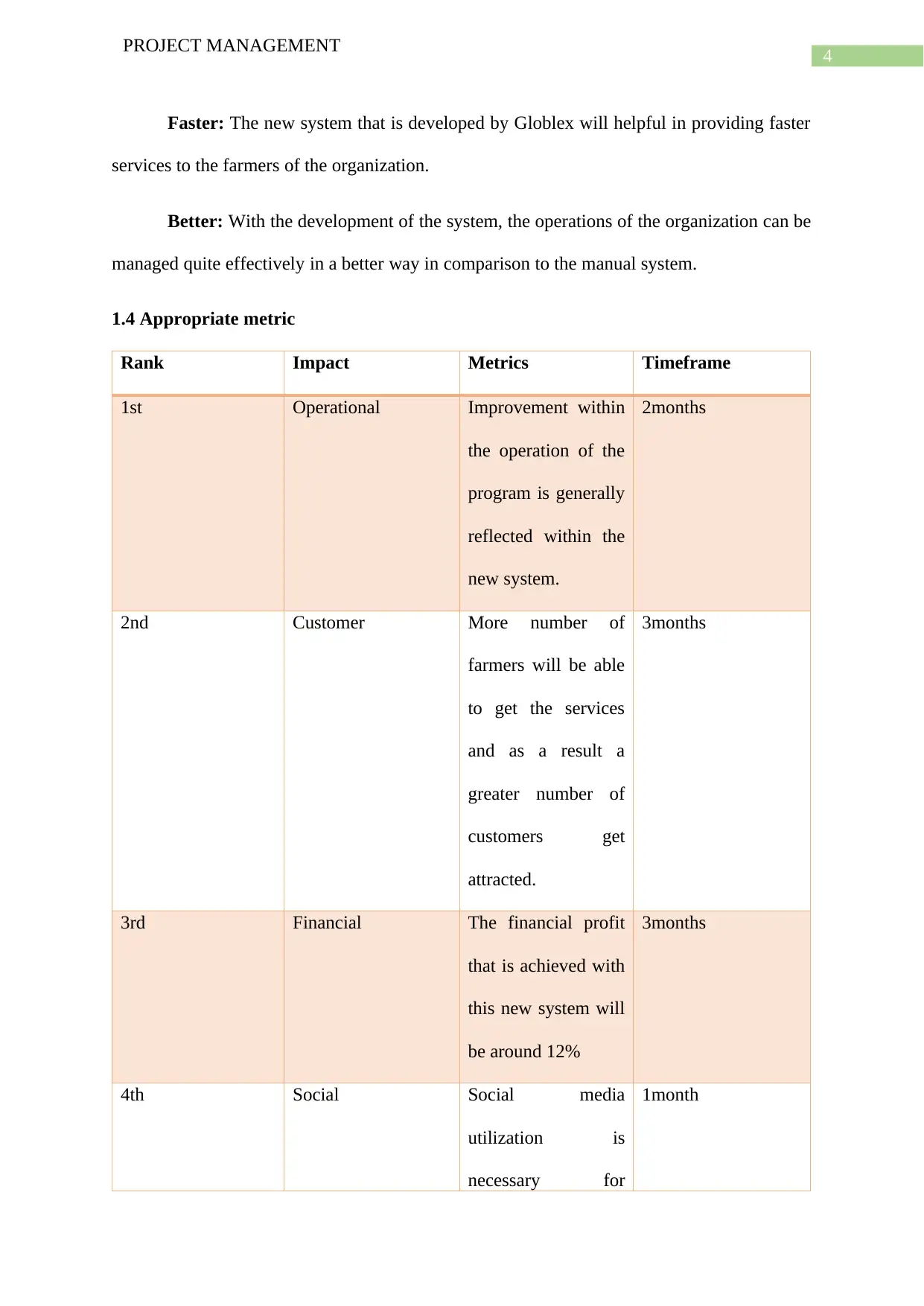
4
PROJECT MANAGEMENT
Faster: The new system that is developed by Globlex will helpful in providing faster
services to the farmers of the organization.
Better: With the development of the system, the operations of the organization can be
managed quite effectively in a better way in comparison to the manual system.
1.4 Appropriate metric
Rank Impact Metrics Timeframe
1st Operational Improvement within
the operation of the
program is generally
reflected within the
new system.
2months
2nd Customer More number of
farmers will be able
to get the services
and as a result a
greater number of
customers get
attracted.
3months
3rd Financial The financial profit
that is achieved with
this new system will
be around 12%
3months
4th Social Social media
utilization is
necessary for
1month
PROJECT MANAGEMENT
Faster: The new system that is developed by Globlex will helpful in providing faster
services to the farmers of the organization.
Better: With the development of the system, the operations of the organization can be
managed quite effectively in a better way in comparison to the manual system.
1.4 Appropriate metric
Rank Impact Metrics Timeframe
1st Operational Improvement within
the operation of the
program is generally
reflected within the
new system.
2months
2nd Customer More number of
farmers will be able
to get the services
and as a result a
greater number of
customers get
attracted.
3months
3rd Financial The financial profit
that is achieved with
this new system will
be around 12%
3months
4th Social Social media
utilization is
necessary for
1month
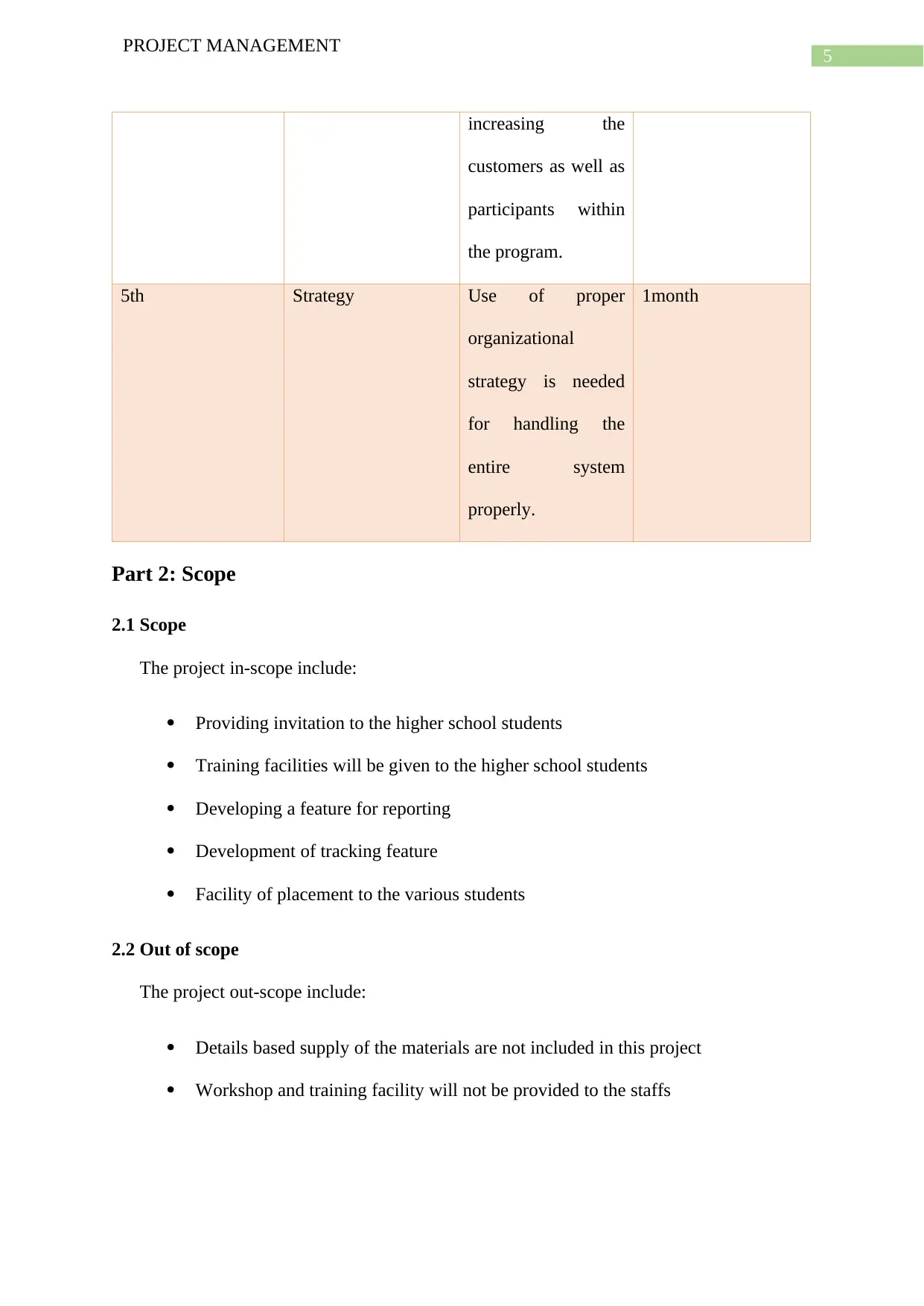
5
PROJECT MANAGEMENT
increasing the
customers as well as
participants within
the program.
5th Strategy Use of proper
organizational
strategy is needed
for handling the
entire system
properly.
1month
Part 2: Scope
2.1 Scope
The project in-scope include:
Providing invitation to the higher school students
Training facilities will be given to the higher school students
Developing a feature for reporting
Development of tracking feature
Facility of placement to the various students
2.2 Out of scope
The project out-scope include:
Details based supply of the materials are not included in this project
Workshop and training facility will not be provided to the staffs
PROJECT MANAGEMENT
increasing the
customers as well as
participants within
the program.
5th Strategy Use of proper
organizational
strategy is needed
for handling the
entire system
properly.
1month
Part 2: Scope
2.1 Scope
The project in-scope include:
Providing invitation to the higher school students
Training facilities will be given to the higher school students
Developing a feature for reporting
Development of tracking feature
Facility of placement to the various students
2.2 Out of scope
The project out-scope include:
Details based supply of the materials are not included in this project
Workshop and training facility will not be provided to the staffs
⊘ This is a preview!⊘
Do you want full access?
Subscribe today to unlock all pages.

Trusted by 1+ million students worldwide

6
PROJECT MANAGEMENT
2.3 Scope management plan
The important steps that are followed in order to manage the scope of the project are
illustrated below:
Defining the various requirements and needs of the project quite effectively so that
the team members can be able to understand the scope of the project effectively.
Understanding the project objectives is considered to be very much important so that
the team members can progress as per the project scope
Analyzing the early sign of scope creep so that the problems that can occur will be
resolved effectively
2.4 Resource plan
People: The individual who help in the information system development are reflected
with the help of figure below:
Figure 1: Human resources
(Source: Created by Author)
Technology: The Technologies that are required are listed below:
PROJECT MANAGEMENT
2.3 Scope management plan
The important steps that are followed in order to manage the scope of the project are
illustrated below:
Defining the various requirements and needs of the project quite effectively so that
the team members can be able to understand the scope of the project effectively.
Understanding the project objectives is considered to be very much important so that
the team members can progress as per the project scope
Analyzing the early sign of scope creep so that the problems that can occur will be
resolved effectively
2.4 Resource plan
People: The individual who help in the information system development are reflected
with the help of figure below:
Figure 1: Human resources
(Source: Created by Author)
Technology: The Technologies that are required are listed below:
Paraphrase This Document
Need a fresh take? Get an instant paraphrase of this document with our AI Paraphraser
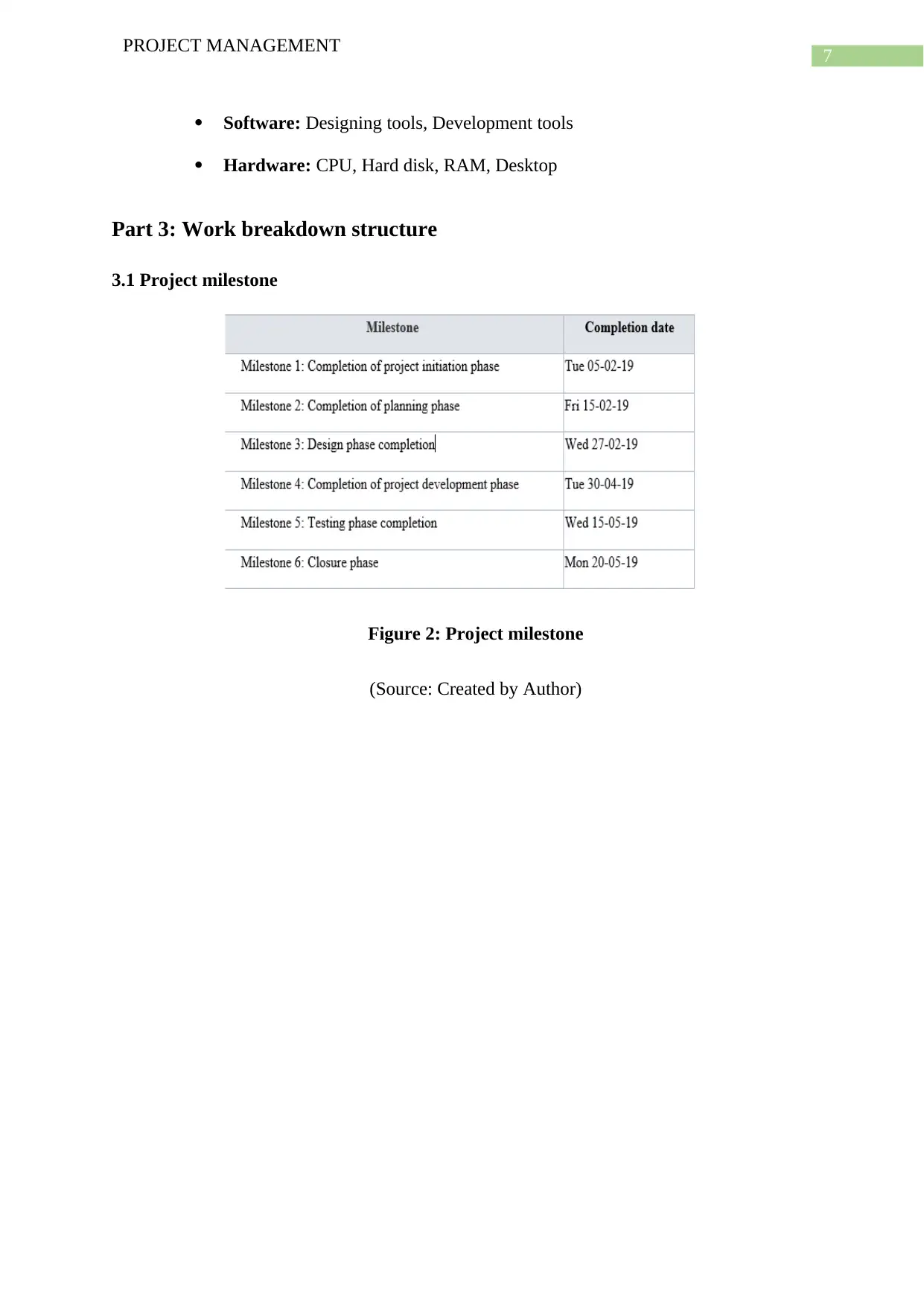
7
PROJECT MANAGEMENT
Software: Designing tools, Development tools
Hardware: CPU, Hard disk, RAM, Desktop
Part 3: Work breakdown structure
3.1 Project milestone
Figure 2: Project milestone
(Source: Created by Author)
PROJECT MANAGEMENT
Software: Designing tools, Development tools
Hardware: CPU, Hard disk, RAM, Desktop
Part 3: Work breakdown structure
3.1 Project milestone
Figure 2: Project milestone
(Source: Created by Author)

8
PROJECT MANAGEMENT
3.2 Project activities
Figure 3: Project activities
(Source: Created by Author)
PROJECT MANAGEMENT
3.2 Project activities
Figure 3: Project activities
(Source: Created by Author)
⊘ This is a preview!⊘
Do you want full access?
Subscribe today to unlock all pages.

Trusted by 1+ million students worldwide
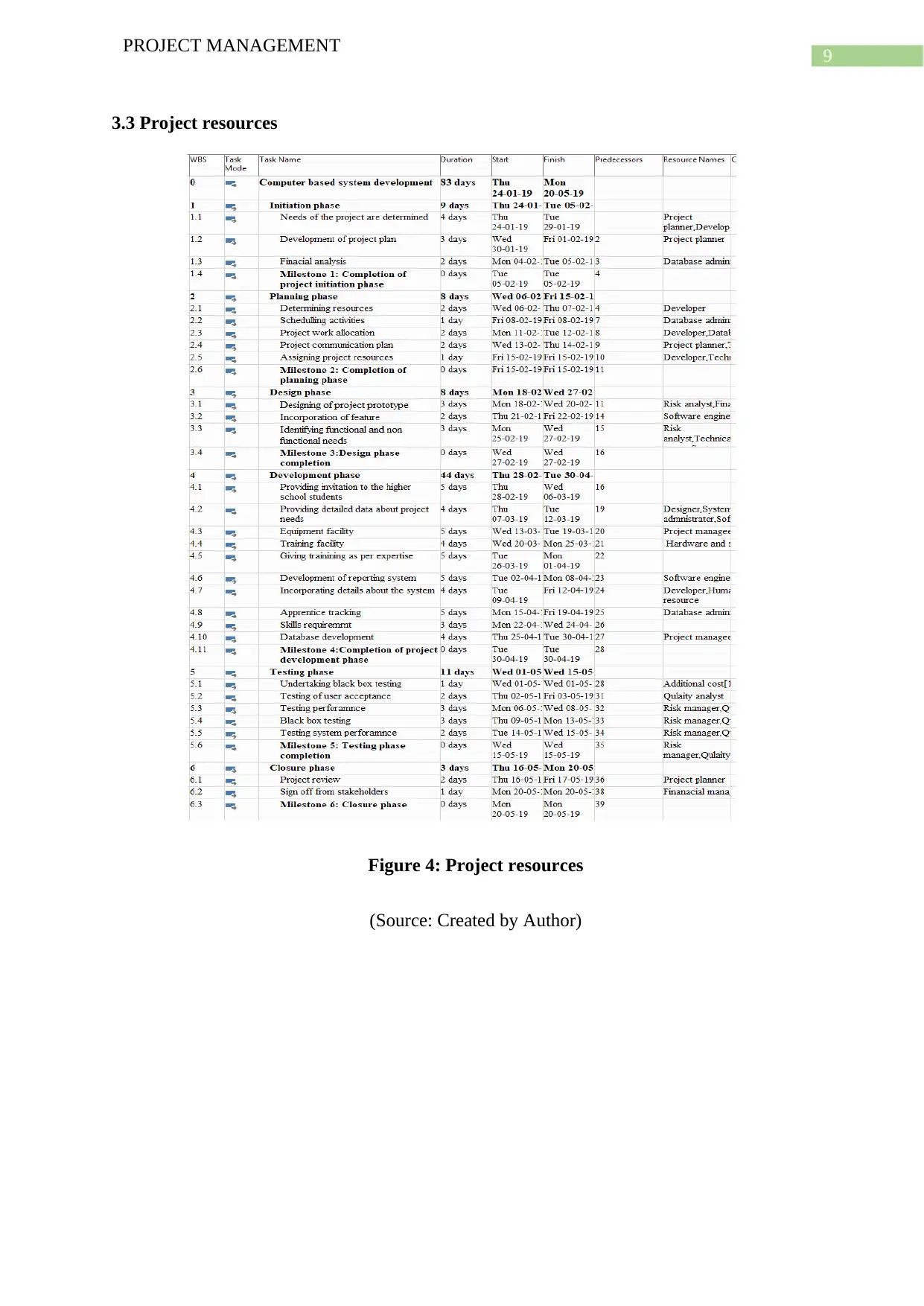
9
PROJECT MANAGEMENT
3.3 Project resources
Figure 4: Project resources
(Source: Created by Author)
PROJECT MANAGEMENT
3.3 Project resources
Figure 4: Project resources
(Source: Created by Author)
Paraphrase This Document
Need a fresh take? Get an instant paraphrase of this document with our AI Paraphraser

10
PROJECT MANAGEMENT
3.4 Time estimation
Figure 5: Gantt chart
(Source: Created by Author)
PROJECT MANAGEMENT
3.4 Time estimation
Figure 5: Gantt chart
(Source: Created by Author)
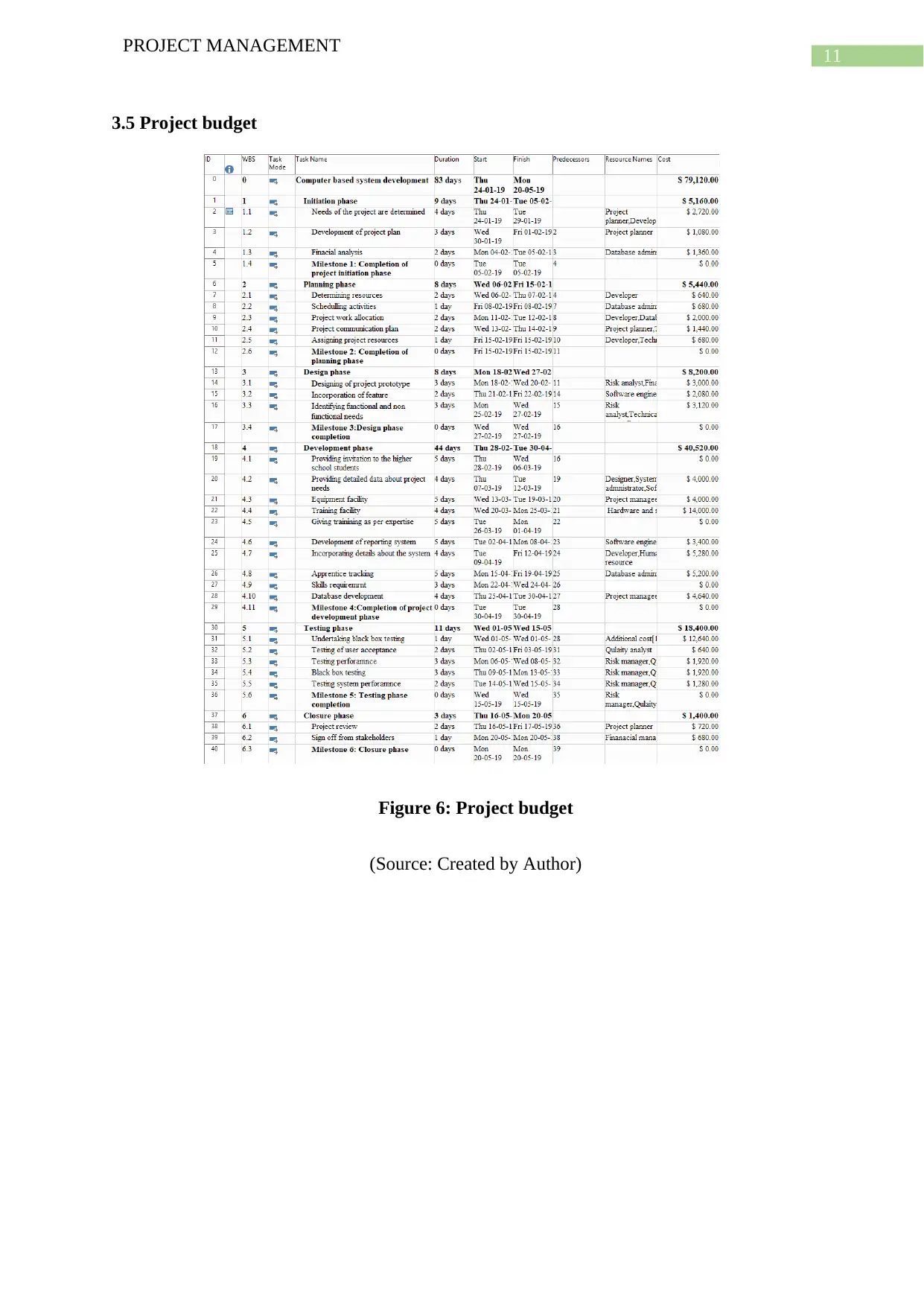
11
PROJECT MANAGEMENT
3.5 Project budget
Figure 6: Project budget
(Source: Created by Author)
PROJECT MANAGEMENT
3.5 Project budget
Figure 6: Project budget
(Source: Created by Author)
⊘ This is a preview!⊘
Do you want full access?
Subscribe today to unlock all pages.

Trusted by 1+ million students worldwide
1 out of 20
Related Documents
Your All-in-One AI-Powered Toolkit for Academic Success.
+13062052269
info@desklib.com
Available 24*7 on WhatsApp / Email
![[object Object]](/_next/static/media/star-bottom.7253800d.svg)
Unlock your academic potential
Copyright © 2020–2025 A2Z Services. All Rights Reserved. Developed and managed by ZUCOL.





